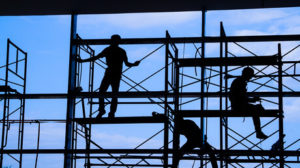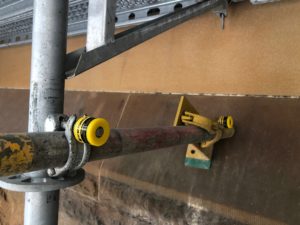Thursday, 25 June, 2020
Originally published by safetysolution.net.au
On 19 May 2020, approximately 20 metres of free-standing perimeter containment scaffolding collapsed into a public street during high winds at Murray Bridge, South Australia. While no-one was injured, the risk was high, prompting SafeWork SA to issue a reminder to businesses to ensure that safe systems of work are in place when using free-standing scaffolding to minimise the risk of a collapse. The collapse or partial collapse of scaffolding poses a serious risk of injury, or death to workers and the general public. It can also cause damage to surrounding structures.
A free-standing scaffold is a scaffold that is not attached to any other structure, yet is stable against overturning on its own account, or if necessary, assisted by stabilisers, outriggers, counterweights or buttress bays. The height of free-standing scaffolding must not exceed three times the minimum base width dimension.
When perimeter containment screens, shade cloth or signs are attached to scaffolding, environmental loads imposed by wind and rain increase the risk of it collapsing or becoming damaged. To avoid the risk of collapse for free-standing scaffolding, businesses need to consult with the scaffold designer or supplier before attaching additional parts that may impose new loads on the scaffold. Businesses must also ensure that the scaffold can withstand any anticipated loads and forces, such as wind loads.
Businesses should consider improving scaffolding stability by staggering the joints in standards, tying the scaffold to a supporting structure, or increasing the stability by securely attaching counterweights. Stability can also be improved by adding bays to increase the base dimension (buttress bays), or attaching stabilisers (back propping). Businesses should also develop procedures to inspect and maintain the scaffold, to ensure it is safe and remains that way.
Scaffold planning and design must ensure the most suitable structure is used to provide safe access to stable working platforms, ensuring the risk of collapse is managed before, during and after its placement. Under the Work Health and Safety Act 2012 (SA), businesses are obligated to ensure the safety of workers and any other persons so far as is reasonably practicable. While everyone in the workplace has work health and safety duties, some have specific responsibilities for scaffolding, including designers, scaffolding contractors and workers who carry out scaffolding work, and principal contractors for construction projects where the cost of construction work is $450,000 or more.
For scaffolding companies, these workers may not only be the workers of the immediate client, but also other workers on the construction site. The scaffolding company must ensure the safety of all those workers. Workers also have specific responsibilities for scaffolding, and must ensure that they do not alter any scaffolding, unless qualified to do so.



